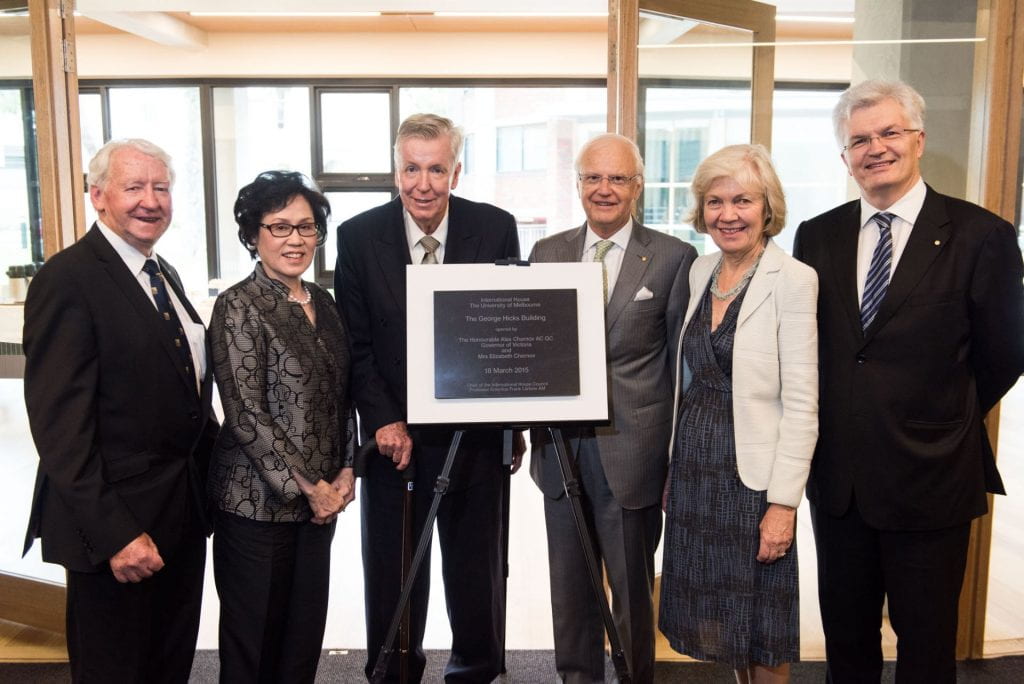
George Hicks Building
George Lyndon Hicks was a resident at International House from 1958 to 1959. He first became interested in aspects of Asian politics and culture at school; his interests expanded while he was studying Arts at the University of Melbourne (Larkins, 2018, p. 27). In 1959, George Hicks became involved in the Immigration Reform Group, a group of University of Melbourne students and staff lobbying for an end to the White Australia Policy (Immigration Reform Group, 1960; Tavan, 2001). In the same year, George Hicks wrote an article on the White Australia Policy for the first issue of Satadal (Hicks, 1959). In it he wrote:
Part of the reason for the great interest and decisive views about White Australia in student circles has been their own experiences in living and working with Asian students. This experience shows that not only are alleged racial and cultural incompatibilities a myth, but that we have much to gain from contact with people of other races.
George Hicks, 1959
In 1960, George Hicks travelled to London to study at the London School of Economics (Larkins, 2018, p. 27). He went on to work in Indonesia, the Philippines, the USA, Japan and Hong Kong and to publish several books (Low, 2016, pp. 16–18).
In 2014, George Hicks provided a generous donation to IH for the construction of a new building for graduate residents. The George Hicks Building, which was built at the rear of 197 Royal Parade, was officially opened on 18 March 2015 (“George Lyndon Hicks”, 2015). It was named in honour of both George Lyndon Hicks and his father the businessman and philanthropist George Franklin Hicks (Low, 2015, p. 27).

Speaking at the opening ceremony, the Governor of Victoria Alex Chernov said: ‘It is obvious enough that in many respects International House has changed significantly since its beginning in 1957, when it opened its doors to 42 young men. 1 But its essential vision has remained unchanged, namely, providing its students of different nationalities and diverse cultures with the opportunity to live and learn together in a community of mutual respect, understanding and international friendship (quoted in Larkins, 2018, p. 195).

References and further reading
George Lyndon Hicks (2015, December). Fraternitas: International House alumni magazine, 14–15. https://ihouse.unimelb.edu.au/__data/assets/pdf_file/0006/1653279/2015_Fraternatis_online.pdf
Hicks, G. (1959). White Australia through Australian eyes. Satadal: The magazine of International House, the University of Melbourne, 33–34. https://blogs.unimelb.edu.au/international-house-melbourne/2019/09/09/white-australia-through-australian-eyes-george-hicks/
Hicks, G. (1989). Hong Kong countdown. Writers’ & Publishers’ Co-operative.
Hicks, G. (Ed.) (1990). The broken mirror: China after Tiananmen. St James Press.
Hicks, G. (1995). The comfort women. Heinemann.
Hicks, G. (1997). Japan’s hidden apartheid. Ashgate.
Hicks, G.L. & McNicoll, G. (1971). Trade and growth in the Philippines: an open dual economy. Cornell University Press.
Immigration Reform Group (1960). Control or colour bar? A proposal for change in Australia’s immigration policy. Immigration Reform Group Melbourne. http://handle.slv.vic.gov.au/10381/182148
Larkins, F. (2018). International House Melbourne: Sixty years of fraternitas. Melbourne University Publishing.
Low. E. (2015). The George Hicks Collection at the National Library, Singapore: An annotated bibliography of selected works. Brill.
Rivett, K. (Ed.) (1962). Immigration: Control or colour bar? The background to ‘White Australia’ and a proposal for change. Melbourne University Press.
Tavan, G. (2001). Immigration: Control or colour bar? The immigration reform movement, 1959–1966. Australian Historical Studies, 32(117), 181–200. https://10.1080/10314610108596160
Templeton, J. (2008). Immigration Reform Group. In eMelbourne: The city past and present, School of Historical and Philosophical Studies, The University of Melbourne. https://www.emelbourne.net.au/biogs/EM00747b.htm
- At this time, International House was open only to male residents. The first female residents arrived in 1972. ↩

